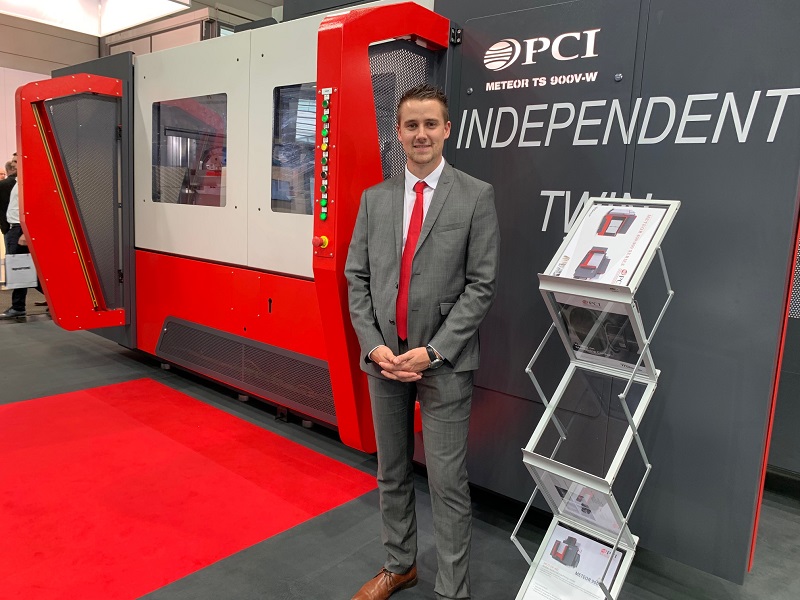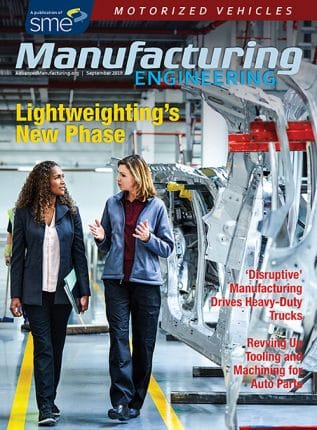Dual-Spindle Technology a Boon to Automakers
This article from Max Paulet, Business Development Manager PCI / Absolute Machine Tools Inc., was printed in the September edition of Manufacturing Engineering Magazine as well as in our Oktoberfest program.

Over its 140-year history, automotive manufacturing technology has evolved in parallel with progress in the vehicles themselves. Early automakers custom made individual “horseless carriages.” Later, standardized parts and moving assembly lines delivered mass-produced cars. Development of integrated transfer lines enabled part runs to extend for years. More recently, manufacturers adopted CNC cells that permit rapid changeovers and engineering updates for changing product lines. Today, digital connectivity expedites global automotive manufacturing.
As a key part of auto manufacturing technology, builders are improving machine tools to maximize flexibility and productivity. For example, CNC horizontal machining centers (HMCs) permit multi-sided machining, maximize chip evacuation, and facilitate pallet-based automation systems. Machines with dual spindles are an evolutionary step in HMC development. They can simultaneously process two separate steps in manufacturing a single part, or machine two different parts. A single machine with two spindles can perform the work of two machines, boosting output while maximizing shop floor space. A typical automotive application for a dual-spindle HMC is machining a transmission assembly composed of a gearbox housing and a clutch housing. With dual-spindle technology, the gearbox housing can be machined on one spindle and the clutch housing on the other, enabling machining of the entire transmission assembly on one machine.
Advanced dual-spindle technology on machines from PCI operate independently of each other. The independence allows them to be manipulated separately without entirely reprogramming the machine. Adjustable distance between the spindles provides application flexibility. Part size capacity is 800 mm rotation diameter and 1,275 mm length. A disc-type tool changer and optional pallet changer speed throughput, and gantry, robotic and manual loading/unloading systems are available.
Independent spindles also minimize the effect that one spindle can have on the other. For example, when machining two gearbox housings on a dual-spindle machine where the spindles are not independent, resonance and vibration from large-diameter reaming on one spindle can negatively affect results from the second spindle. A machine with independent spindles does not have that problem.
Moving up to Industry 4.0

Also, new machine tools are enabling Industry 4.0, which integrates data acquisition, storage, and sharing technologies into the manufacturing process. Networked, sensor-based systems analyze ongoing operations in real time and route data for cloud sharing and storage. The systems compare the ongoing data to established machining models to optimize machining processes.
Data-integrated machines from PCI obtain and use information in many ways, such as employing sensors to detect vibrations as an indication of machining problems. Also, spindle operation itself can be analyzed. Because spindle health is vital, monitoring it enables maintenance scheduling that prevents unanticipated downtime.
These dual-spindle HMCs play a growing role in auto parts manufacturing, including internal combustion parts such as gearbox housings and cylinder blocks, as well as electric motor housings and battery tray components for hybrid and fully electric vehicles. They can also produce structural and suspension components, including steering arms and knuckles as well as aluminum parts for nearly any auto application.
Author’s note: PCI’s dual-spindle technology will be on display at Absolute Machine Tools’ Oktoberfest event, to be held October 24 in Lorain, Ohio. Call 866-807-1243 for information.



